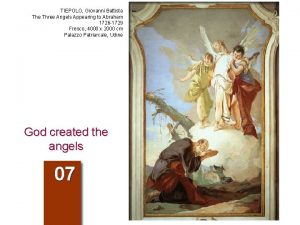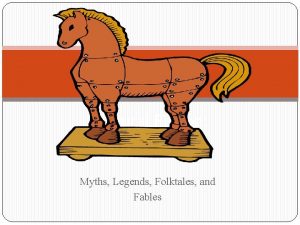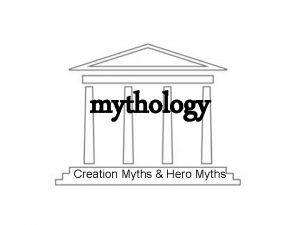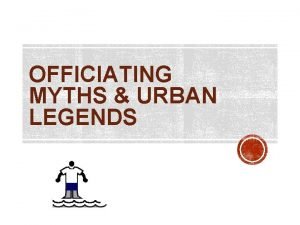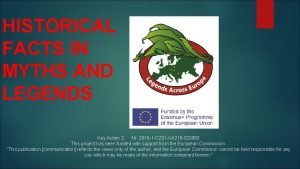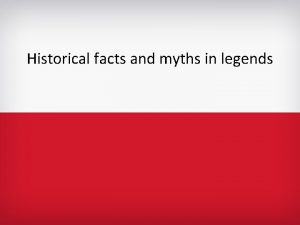Historical facts myths and personalities appearing in Polish













































- Slides: 45

Historical facts, myths and personalities appearing in Polish legends.

Jakub Wejher

Jakub Wejher (1609 -1657) He was a member of the Polish line of the Weyher family, a Count of the Holy Roman Empire and member of the Polish– Lithuanian Commonwealth szlachta. Wejher was the Castellan of Puck and Voivode of Malbork (Marienburg) from 1643– 1657, the Castellan of Chmielno, and the Starost of Człuchów, Kiszporek, Bychów and Brzechowo. He is remembered as a pious and tolerant magnate and an experienced military leader.

Biography He was a member of a rich magnate family originating from Westphalia. He studied first at a Jesuit College in Braniewo, then abroad at the University of Bologna. He was a Catholic and a supporter of the Counter-Reformation.

Pursuing traditions of his family, as a youth he joined foreign military. In the years 16281632 he fought in the Thirty Years' War in the Holy Roman Empire in the armies of the Catholic League, commanding a cavalry unit under Albrecht von Wallenstein. At some point he visited Malta. In 1632 he returned to Poland. As part of Poland's royal army he fought in the Smolensk War (1633– 1634), The Deluge, Russo-Polish War (1654– 67) and the Chmielnicki Uprising.

During the Deluge - the Swedish invasion of Poland - unlike many commanders in the north of Poland, he did not switch sides and defect to the Swedes. Instead he defended Malbork for two months before capitulating. He was able to obtain from the Swedes a safe passage of his troops which retained their arms; he would soon join the Polish king in the south and would continue to fight the invaders.

He supervised the construction of Władysławowo, a fledging port for the Polish –Lithuanian Commonwealth Navy. He founded the town of Wejherowo and in it, the Kalwaria Wejherowska chapel complex (fulfilling an oath he took when he nearly died during the Smolensk War at Biała in 1634).

Over the years he founded several other monasteries, churches, as well as secular settlements. Despite being an ardent Catholic, he has proven to be a tolerant ruler, and supported peaceful dealings with the Protestants. He was buried in St. Ann Church in Wejherowo.

The legend says that line of the Weyher family comes from German knight from Wurzburg in Frankonia, who had to be courtier or knight of Holy Roman Emperor in ninth century. Another historians claims that Weyher line comes from poor, wandering knight, who in fourteenth century came to Pomerania for food.

Monument to Jakub Wejher as the town's founder in Wejherowo

Jan III Sobieski

John III Sobieski (1629 – 1696) From 1674 until his death King of Poland Grand Duke of Lithuania, was one of the most notable monarchs of the Polish–Lithuanian Commonwealth.

Sobieski's military skill, demonstrated in wars against the Ottoman Empire, contributed to his prowess as King of Poland. Sobieski's 22 -year reign marked a period of the Commonwealth's stabilization, much needed after the turmoil of the Deluge and the Khmelnytsky Uprising.

Popular among his subjects, he was an able military commander, most famous for his victory over the Turks at the 1683 Battle of Vienna. After his victories over them, the Ottomans called him the "Lion of Lechistan"; and the Pope hailed him as the savior of Christendom.

After graduating from the Nowodworski College in Kraków in 1643, young John Sobieski then graduated from the philosophical faculty of the Jagiellonian University in 1646. After finishing his studies, together with his brother Marek Sobieski, John left for western Europe, where he spent more than two years travelling.

Both brothers returned to the Commonwealth in 1648. They volunteered for the army. Sobieski's greatest success came in 1683, with his victory at the Battle of Vienna, in joint command of Polish and German troops, against the invading Ottoman Turks under Kara Mustafa. The Pope and other foreign dignitaries hailed Sobieski as the "Savior of Vienna and Western European civilization. "

Although the King spent much time on the battlefields, which could suggest a good state of health, towards the end of his life he became seriously and increasingly ill. King John III Sobieski died in Wilanów, Poland on 17 June 1696 from a sudden heart attack. He is interred in Wawel Cathedral, Kraków, Poland.

Polish legends says that famous oak called , , Bartek” is tied with the Polish nation. In times of peace the tree was growing quietly, and in times of danger adversities were happening to him.

One day trunk of , , oak Bartek” burst. Everyone considered that bursting is due to the attack of Turkish troops on Europe. After winning the battle of Vienna Sobieski came to , , oak Bartek” and hid in a hole gained in battle treasures. The next night in the trunk of oak there was no trace of the hole.

Sobieski's coronation(1676)

Relief of Vienna by Bacciarelli

Monument of John III Sobieski in Gdańsk, moved from Lwów after World War II

Mistrz Twardowski A Polish nobleman, who according to the tradition, sold his soul to the devil. He is the hero of several fairy tales and legends, fairy tales, of which almost each representing a different story. One of the most well-known, says that he is actually on the moon.

Form Pan Twardowski is modeled probably one of the creators of King Sigismund Augustus, Jan Twardowski. Similarly, in fact, it exists and assign it was to call the spirit of the late Barbara Radziwiłłówna. On the other hand, some researchers have for the first historical mention of Twardowski recognize the document found in the archives of the Diocese of Plock in 1495 mention sorcerer named Twardosky.

Master Twardowski with the devil

According to legend, Twardowski was a nobleman living in Kraków in the sixteenth century. He sold his soul to the devil in exchange for knowledge and great knowledge of magic. He wanted, however, to outwit the devil, so the pact signed with the added paragraph says that the devil can take his soul to hell only in Rome, which was not planned to visit.

Mr. Twardowski evokes the spirit of Barbara Radziwiłłówna

With the help of the devil Twardowski gained wealth and fame, eventually becoming a courtier of King Sigismund Augustus. The king, who after the death of his wife surrounded himself with astrologers, alchemists and magicians. As proclaim legend, Twardowski was able to call up the spirit of a deceased Barbara through the use of magic mirrors Twardowski.

After many years, the inn under the name of Rome, the devil caught in the end Twardowski. At the time of the abduction same he had to pray to Mary (or according to another version of the Church sing a song), in which the devil lost it along the way. Twardowski landed on the moon, where it is today, watching the actions of people on Earth.

Another legend says that the devil freed Twardowski, as cyrografie was taken into account, which can take care of his soul, when Rome terminates his name. And according to legend - a name that no one knew. Twardowski returned it to the devil, when he took her with him. He let go so Twardowski devil, and he instead fall to the ground, landed on the moon. It is today.

Lech, Czech and Rus The legend of three brothers Lech, Czech and Rus who settled in the west, south and east, and gave birth to zachodniosłowiańs kim separate countries: Poland, Czech and Slavic East of Russia.

Today they symbolize brotherhood of Czechs and Poles, but also have a specific theory about the life of Czechs and yhe original land of Slavs in Central Europe.

History The legend has been saved for the first time in Latin in the so-called. Chronicle of Polish. Hungarian, dating back to 1222. Historians Its content covers the time up to the tenth century. Year reign of the Hungarian King Ladislaus I of the Holy. Chronicle describes the journey of three Slavic princes: Czech, Lech and Rus, who are from the former Croatia, where there was a Slavic states Karantania, went north and launched the first Moravian, and later the new Slavic countries: the Czech Republic, Poland Rus.

Polish Chronicle describes the three brothers, Lech, Czech and Rus, who assume three Slavic nations: Czechs, Poles and Lechitów / Rus / Ruthenian. Czech Dalimil Chronicle describes two brothers Lech and the Czech Republic.

Jan Dlugosz evolved legend Chronicles of Wielkopolska, which Rusa one of the descendants of Lech. He inherited part of the country Lechitów, called from now Rusa descendant according to Dlugosz was a Germanic chieftain Odoacer.

For those legendary topics returned studies later writers, Polish and Czech. Alois Jirásek wrote in 1894, a legend in his book "Old Czech Pověsti" where two brothers, Čech and Lech, appears in Central Europe from the east.


Jadwiga Andegaweńska b. between 3 October 1373 and 18 February 1374 in Buda, died. July 17, 1399 in Krakow - Polish Queen of the Angevin dynasty, the daughter of Louis of Hungary and Elizabeth of Bosnia, 1384 crowned Polish king, holy Catholic Church, the patron of Polish.


Throne and coronation At the congress of chivalry in Radomsko (November 1382) he was elected Jadwiga of Anjou Polish king. In the fall of 1384 came from Hungary to Polish. October 16 this year in Krakow was crowned by the Archbishop of Gniezno Bodzanta Polish king. Due to the minority reins of the country in which men held Malopolska, he was in contact with his mother Elizabeth Bosnia, but not appointed regent, because, as he writes Jan Dlugosz, everything said or indicated ripe old age of seriousness.

Death and burial June 22, 1399 gave birth to daughter Elizabeth Boniface, who died on July 13, 1399 year. Jadwiga died four days later, probably in the postpartum fever. In his will, he wrote his fortune Academy of Krakow. When in the 80 s of the twentieth century [needed footnote] opened her tomb, located in the Wawel Cathedral, it was found that the tomb jewels were made of leather and wood.

Tomb widely revered Queen has not found a decent silhouette of its unique position and merit. Perhaps in anticipation of the imminent canonization of Jadwiga of Anjou delay construction of a more stately tomb. For over 200 years the modest plate or Tumba over the burial of the queen was on the north side of the chancel, next to the main altar of the cathedral. According to sources, the sixteenth-century inscription on the grave of Jadwiga of Anjou was: Sidus Polonorum, hic iacet Hedvigis eorum Regina (Star Poles, here is Queen Jadwiga).

Headstone of Jadwiga of Anjou in the Wawel. The original can limestone slab tomb Jadwiga was destroyed during the reconstruction of the chancel of the cathedral in the 1 st half. The seventeenth century. At that time, the unmarked burial place of Queen disappeared beneath a new floor. In 1634 the black marble plaque with the inscription new, founded by Bishop Peter Gembicki, located to the left of the high altar, the increase in show floor.


Wiktoria Gacek & Kinga Goyke
 Poland urban legends
Poland urban legends Reversed polish notation
Reversed polish notation Reverse polish notation
Reverse polish notation Who are called historical personalities
Who are called historical personalities Hurricanes myths and facts
Hurricanes myths and facts The three angels appearing to abraham
The three angels appearing to abraham Myths and legends quiz questions and answers
Myths and legends quiz questions and answers What is genre
What is genre Turkic mythology
Turkic mythology Eurydice
Eurydice Legends and myths difference
Legends and myths difference Myths legends fables and fairy tales
Myths legends fables and fairy tales Stories once passed down orally
Stories once passed down orally Myths and legends of king arthur
Myths and legends of king arthur Hediod
Hediod Elements of science fiction and myths legends folktales
Elements of science fiction and myths legends folktales Fables
Fables Irish myths and legends lesson plans
Irish myths and legends lesson plans Equation for drag
Equation for drag Fairy tale jeopardy
Fairy tale jeopardy Anasazi mythology
Anasazi mythology What is a myths meaning
What is a myths meaning Myth and fallacies about non-communicable diseases
Myth and fallacies about non-communicable diseases Folktales examples
Folktales examples Heroes myths and legends
Heroes myths and legends Multiplication facts and division facts
Multiplication facts and division facts In disc, people with s personalities
In disc, people with s personalities Personality test color code
Personality test color code Colorcode personality test
Colorcode personality test Https //16 personalities.com/free-personality-test
Https //16 personalities.com/free-personality-test 16 personalities.com/free-personality-test
16 personalities.com/free-personality-test Other personality traits relevant to ob
Other personality traits relevant to ob 12 personalities
12 personalities Https //www.16 personalities.com/free-personality-test
Https //www.16 personalities.com/free-personality-test Tao of pooh which character are you
Tao of pooh which character are you Www.16 personalities.com/personality-types
Www.16 personalities.com/personality-types M&m personality test
M&m personality test Teamwork personality
Teamwork personality Biographies of salvadoran personalities
Biographies of salvadoran personalities Famous personalities quiz
Famous personalities quiz Logistician personality definition
Logistician personality definition 16 personalities.com/free-personality-test
16 personalities.com/free-personality-test 16 personalities.com
16 personalities.com Creation myth definition
Creation myth definition What is management myths in software engineering
What is management myths in software engineering Myths about pirates
Myths about pirates





